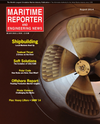
Page 61: of Maritime Reporter Magazine (August 2014)
Shipyard Edition
Read this page in Pdf, Flash or Html5 edition of August 2014 Maritime Reporter Magazine
www.marinelink.com 61sen Eils, Cuxhaven, a ferry to navigate in the Helgoland-Service. This is signi Þ -cant in that it is the Þ rst newbuild under German ß ag equipped with environmen- tally friendly LNG technology. Another innovation emanating from Germany comes in the form of Aeolus, which was delivered in February 2014 and was a premiere in German shipbuild-ing as it was the Þ rst Jack-Up designed and built in Germany. It was constructed at the Sietas Yard for Dutch hydraulic engineering company Van Oord. In Bremerhaven, Lloyd Werft cannot complain about a lack of work. ?We real- ize an intensive demand about our skills in the special ship building process, but remain also Þ rst port of call for repairs and modiÞ cations for cruise ships,? said Rüdiger Pallentin, CEO, Lloyd Werft. After the cruise ships ?Explorer? and ?Mein Schiff1? were delivered in April and May last year, respectively, the yard signed during the International Cruise Shipping in Miami a contract for the repair of the U.S. cruise ship ?National Geographic Explorer? (112 m long, 6,471 BRT) with its owner U.S. shipping company Lindblad Expedition Inc.Strong Export Share The combined turnover of all ship and boat building yards (including navy ship-building, repairs, modiÞ cations, inland shipping, etc.) are for the Þ rst three quar- ters, according to information from the Federal Statistical OfÞ ce, in total $4.6 billion, slightly less than the comparable period in 2012 which was $5.3 billion. In total, approximately 98 percent of the civil ship building output are for export, which is similar to the last few years.Export is traditionally also important for the shipbuilding supply industry. VDMA, the German Engineering Fed-eration, reports that around 400 supply companies feature an average export rate of 74 percent. They bene Þ t substantially from the increase of the worldwide ship-building demand and particularly of the increasing energy ef Þ ciency, which is a particular strength of the German manu-facturer. In Germany the ship building supply industry employs about 68,000 with an annual turnover of around $16B. After the historic shipbuilding run and its abrupt end due to the global Þ nan-cial crisis, the ship supply picture has morphed, and today about 40% of the companies experienced growth in 2012, while about 33% reported a decline in sales. VDMA economic data delivered for 2013 again paints a positive picture for the entire maritime supply branch. The increase of the order incomes con-tinued in 2012 at about four percent, a growth rate conÞ rmed in 2013, too. By sector, the offshore market continues to grow in importance in Germany, and it will be an important task for German companies to strengthen their presence in this market to increase overall sales growth. While the shipbuilding industry has certainly changed mightily in Ger- many ? and in fact worldwide ? it is clear that shipbuilding and ocean engineering are industries with big growth opportu-nities. As the world?s population contin- ues to grow, so too will the requirement for food, commodities and energy, all of which travel liberally on the seas.Germany has the best conditions in these markets to play an important role ? because solutions for these highly am-bitious challenges can only be created with the best engineering activities. Also in these difÞ cult times a particular fo- cus is on education at all levels, another strength of Germany and the technical markets it serves.MR #8 (58-63).indd 61MR #8 (58-63).indd 618/7/2014 3:46:45 PM8/7/2014 3:46:45 PM

 60
60

 62
62
